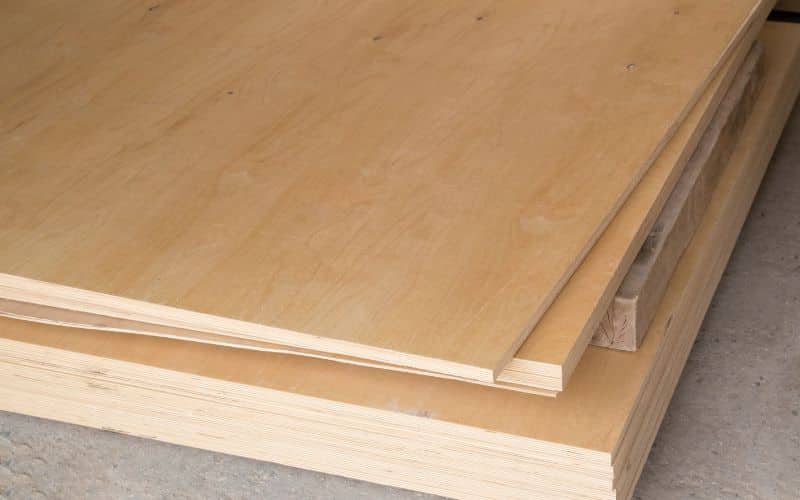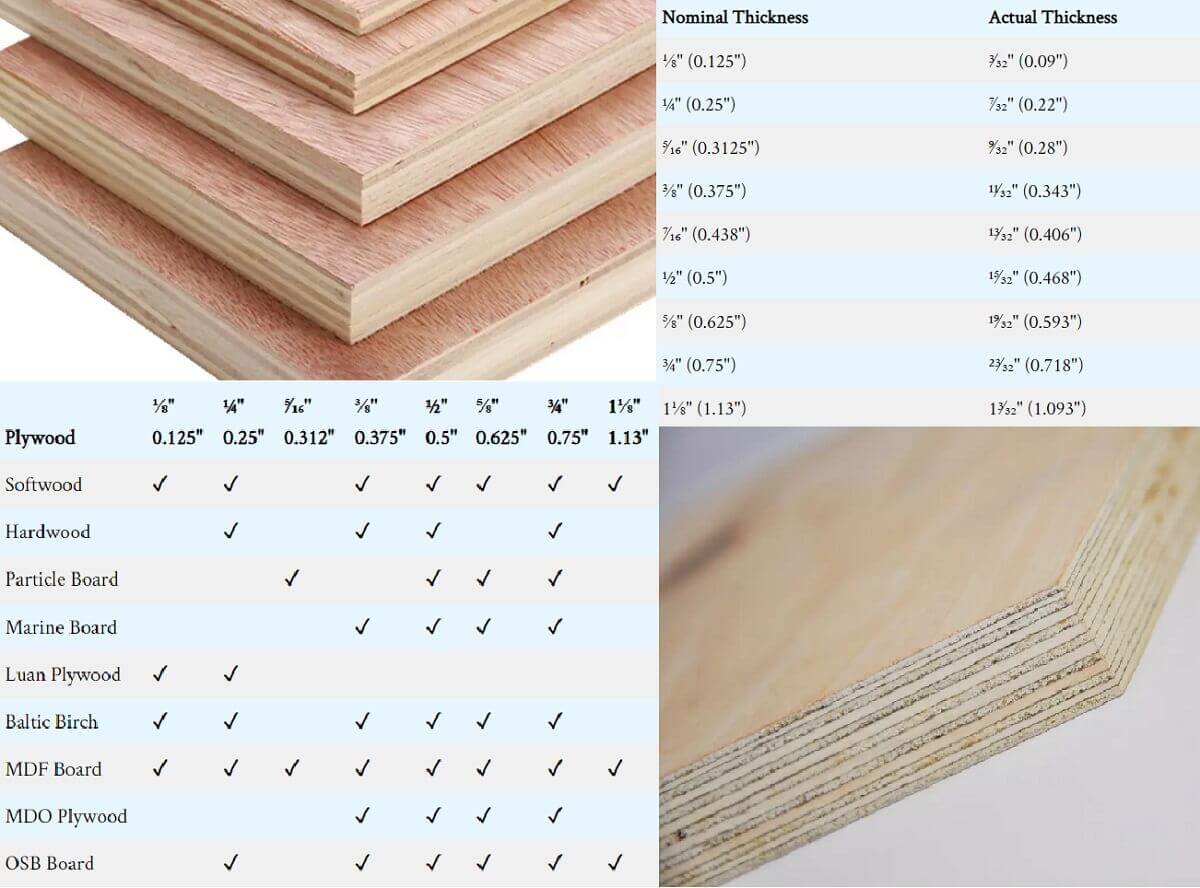If you’re wondering about the durability of plywood and how long it lasts, you’ve come to the right place! Plywood is a versatile material used for various projects, from construction to crafting. So, how long is plywood good for? Let’s dive in and find out!
Plywood is made by layering thin sheets of wood together, creating a sturdy and resilient material. But just like anything else, its lifespan can vary depending on factors such as usage, environment, and maintenance. So, let’s explore how long plywood can hold up before you might need to consider replacing it.
Whether you’re a DIY enthusiast or a professional contractor, understanding the longevity of plywood is essential for planning and executing your projects effectively. So, let’s explore the factors that can impact how long plywood remains in good condition.

How Long is Plywood Good For?
Plywood is a versatile and commonly used building material. It is made by gluing together thin layers of wood veneers, creating a strong and durable sheet. But how long can plywood be expected to last? In this article, we will explore the factors that influence the lifespan of plywood and provide you with valuable information to help you understand how long plywood can remain in good condition. So, if you’re a DIY enthusiast, a homeowner, or a construction professional, read on to discover the answer to the question, “how long is plywood good for?”
Factors Affecting the Lifespan of Plywood
Plywood, like any other material, is influenced by various factors that determine its lifespan. Understanding these factors can help you make informed decisions about using and maintaining plywood in different applications. Let’s take a closer look at some of the key factors that affect the durability of plywood:
1. Quality of Plywood
The quality of plywood plays a significant role in its longevity. High-quality plywood, which is made from strong and durable wood species, will generally last longer than lower-quality alternatives. Factors such as the type of glue used, the thickness of the veneers, and the manufacturing process can all influence the quality of plywood. It is essential to choose plywood that meets the required standards for your specific application to ensure its long-term performance.
2. Environmental Conditions
The environment in which the plywood is installed or stored greatly impacts its lifespan. Plywood is sensitive to changes in temperature, humidity, and exposure to moisture. If plywood is constantly exposed to high humidity levels or direct sunlight, it can lead to warping, delamination, and decay. Similarly, prolonged exposure to moisture can cause the wood fibers to swell and weaken. Proper installation, regular maintenance, and the use of protective finishes can help mitigate the impact of environmental conditions on plywood.
3. Maintenance and Care
Regular maintenance and proper care can significantly extend the lifespan of plywood. This includes keeping the plywood clean, inspecting it for any signs of damage or decay, and promptly addressing any issues that arise. Applying protective coatings, such as paints, stains, or sealants, can also enhance the durability of plywood. Regularly checking for and repairing any loose veneers or damaged edges can prevent further deterioration and ensure the longevity of plywood.
4. Intended Use and Load-Bearing Capacity
The lifespan of plywood also depends on its specific application and the load it is expected to bear. Plywood used for structural purposes, such as flooring or roofing, needs to meet higher standards of durability. Properly designed and installed plywood structures can last for several decades. On the other hand, plywood used in temporary applications or subjected to heavy loads may have a shorter lifespan. Understanding the intended use and load-bearing capacity of plywood is crucial in determining its expected longevity.
5. Pest Infestation and Fungal Decay
The presence of pests, such as termites or wood-boring beetles, can significantly diminish the lifespan of plywood. These organisms feed on the wood fibers, causing structural damage and weakening the plywood. Similarly, fungal decay caused by moisture infiltration can lead to rotting and decay of the wood fibers. Proper treatment and preventive measures, such as using pressure-treated or termite-resistant plywood, can help mitigate the risk of pest infestation and fungal decay, ensuring the longevity of plywood.
6. Exposure to Chemicals
Plywood that is exposed to harsh chemicals, such as solvents or corrosive substances, may experience accelerated deterioration. Chemicals can break down the glue bonds in plywood, causing delamination and weakening the overall structure. It is crucial to consider the potential exposure to chemicals in the intended use of plywood and choose appropriate materials or protective coatings to ensure its longevity.
7. Regular Inspections and Repairs
Regular inspections and timely repairs are crucial in maintaining the longevity of plywood. Periodic visual inspections can help identify any signs of damage or decay, allowing for prompt repairs. Loose veneers, damaged edges, or signs of pest infestation should be addressed immediately to prevent further deterioration. By being proactive in maintaining and repairing plywood, you can extend its lifespan and ensure its continued usefulness.
How Long Can Plywood Last in Different Applications?
Now that we have discussed the factors affecting the lifespan of plywood let’s explore how long plywood can be expected to last in different applications. While the exact lifespan of plywood can vary depending on the factors mentioned above, we can provide some general guidelines based on common uses:
1. Plywood in Indoor Applications
When used indoors, plywood can have a long lifespan if properly maintained. In dry and controlled environments, such as furniture, cabinets, or interior wall paneling, plywood can last for several decades. Regular inspections and maintenance, including keeping the surfaces clean and free from moisture, can help prolong its lifespan.
2. Plywood in Exterior Applications
Exterior plywood, commonly used in applications such as sheathing, roof decking, or siding, requires additional protection and maintenance to withstand the elements. With proper installation, regular inspections, and maintenance, exterior plywood can last anywhere from 20 to 30 years or more. Applying weather-resistant coatings, ensuring proper drainage, and addressing any signs of damage promptly can help extend its lifespan.
3. Marine Plywood
Marine plywood is specifically designed to withstand constant exposure to moisture and harsh marine environments. It is often used in boat construction, docks, and other water-related applications. Marine plywood, if used and maintained properly, can have a lifespan of 25 to 30 years or more. Regular inspections, sealing the exposed edges, and using appropriate marine-grade coatings are essential for maximizing its longevity.
Summary
In conclusion, the lifespan of plywood depends on various factors such as quality, environmental conditions, maintenance, intended use, pest infestation, exposure to chemicals, and regular inspections. High-quality plywood, when used in appropriate applications and maintained correctly, can last for several decades. However, environmental exposure, pests, and neglect can significantly shorten its lifespan. By understanding these factors and taking the necessary precautions, you can ensure that your plywood remains in good condition for an extended period, ultimately maximizing its value and utility. So, next time you wonder, “how long is plywood good for?” consider these factors and give your plywood the care it deserves.
Key Takeaways: How Long is Plywood Good For?
- Plywood can last for a very long time if properly stored and maintained.
- On average, plywood can remain in good condition for about 20 to 30 years.
- The lifespan of plywood depends on factors like exposure to moisture, temperature, and the quality of the wood.
- Using pressure-treated or marine-grade plywood can increase its durability and lifespan.
- Regular inspections and maintenance, such as sealing the edges and protecting it from excessive moisture, can help prolong its lifespan.
Frequently Asked Questions
When it comes to the durability of plywood, there are several factors to consider. Here are some common questions related to how long plywood is good for and their answers.
1. How long does plywood typically last?
The lifespan of plywood largely depends on its quality, the environment it’s exposed to, and how well it is maintained. Generally, high-quality plywood can last anywhere from 20 to 30 years or even longer with proper care. However, plywood that is constantly exposed to moisture or extreme weather conditions may have a shorter lifespan.
To maximize the lifespan of plywood, it’s crucial to protect it from moisture, sunlight, and other elements. Regular inspections, prompt repairs, and proper sealing or painting can help extend its longevity. Additionally, following the manufacturer’s guidelines for maintenance and usage will contribute to a longer lifespan.
2. Can plywood be used for outdoor projects?
Yes, plywood can be used for outdoor projects, but not all types of plywood are suitable for prolonged exposure to the elements. Exterior-grade plywood, which is designed to withstand moisture, is the best choice for outdoor applications. It is typically made with water-resistant adhesives and may have additional treatments to enhance its durability.
Even with exterior-grade plywood, it’s important to protect it further by sealing or painting the surface to prevent water penetration. Regular maintenance, including checking for signs of damage or rot, is recommended to ensure its longevity when used outdoors.
3. How does the thickness of plywood affect its lifespan?
The thickness of plywood can impact its lifespan in different ways. Thicker plywood generally offers better strength and durability, making it less prone to warping, sagging, or breaking. This can contribute to a longer lifespan, especially for structural applications that require support and stability.
However, thicker plywood may also be heavier and more expensive. For non-structural or decorative projects, thinner plywood may be sufficient and still provide a reasonable lifespan if properly maintained. It’s essential to choose the appropriate thickness based on the specific application and consider the expected load or stress the plywood will endure.
4. Is there a way to increase the lifespan of plywood?
Yes, there are steps you can take to increase the lifespan of plywood. Proper installation is essential, ensuring that it is secured correctly and protected from excessive moisture. Applying a coating, such as paint or sealant, can help create a barrier against water and protect the wood from decay. Regular cleaning and maintenance, such as removing debris or stains, also contribute to its longevity.
Additionally, controlling the environment is important. Avoid exposing plywood to prolonged periods of direct sunlight or extreme temperature variations, as this can cause warping or degradation. Regular inspections to identify and address any issues promptly will help extend the lifespan of plywood.
5. Can plywood be recycled or reused?
Yes, plywood can be recycled or reused in various ways. When plywood reaches the end of its lifespan, it can be recycled into new wood products or used as fuel for energy production. Recycling centers or waste management facilities often accept plywood for proper disposal.
Alternatively, plywood can be repurposed or reused for different projects. It can be used as a construction material for non-structural applications, such as shelves or furniture. With some creativity, plywood can find new life in DIY projects or even be donated to organizations that promote reuse and upcycling.

Summary
So, how long is plywood good for? The answer depends on a few key factors. Firstly, the quality of the plywood itself plays a crucial role. Higher quality plywood tends to last longer. Secondly, the way you store and protect the plywood also matters. Keeping it dry and away from extreme temperature changes will help extend its lifespan. Lastly, regular maintenance, such as sealing the edges, can help prolong the life of plywood.
In conclusion, if you want your plywood to last as long as possible, invest in high-quality plywood, store it properly, and perform routine maintenance. By taking these steps, you can ensure that your plywood remains in good condition for a considerable amount of time. Remember, a little extra care can go a long way in preserving the durability of your plywood.
